How Asparagus Grows: Outdoor Growing and Care for Beginners
Canteen asparagus - a relative of indoor asparagus. It is a valuable and nutritious vegetable. Its tasty sprouts contain vitamins A, C, group B, iron, calcium, sodium, magnesium, manganese, copper and selenium. Although asparagus is a demanding crop, its cultivation does not require serious material and physical costs.
In this article, we will take a closer look at how to grow asparagus yourself.
The content of the article
How asparagus grows in the garden
The first thing that a summer resident who decides to plant asparagus should learn: he will receive a tasty harvest only in the third year of cultivation... This is due to the biological characteristics of the plant.
For planting asparagus, choose a sunny place, protected from drafts. Sandy and poor soils will not work. The ideal soil is loose, has neutral acidity, and is rich in humus.
Reference! Asparagus is a delicacy, equated to artichokes and truffles.
Photo of how asparagus grows:

Landing dates
Before planting asparagus, the soil is pre-prepared. The seeds of this vegetable crop can withstand even severe frosts, so asparagus is sown both in spring and before winter.
In the spring
Dug up a bed for asparagus, add rotted manure (5-8 kg per m2) and lime to neutralize acidic soil. If the soil is heavy, it is loosened with peat or sand.
When sown at the end of April, seedlings will appear after the May holidays. In early spring, the average daytime temperatures are relatively low, the soil does not have time to dry out and asparagus grows together. The culture loves space: only 4 plants fit per 1 m2.
Planting pattern: 30 cm between plants and 60 cm between rows.
In autumn
With winter sowing of asparagus, organic matter is not introduced into the soil.
Digging up the ground, add a mixture of mineral fertilizers (per 1 m2):
- superphosphate - 60 g;
- potassium sulfate - 30 g;
- ammonium sulfate - 20 g.
The planting scheme is the same as in the spring. A small embankment is formed above each next to the crops, as when hilling. This will protect the crops from frost.
Reference! In one place without transplants asparagus grows up to 20 years.
Seed preparation
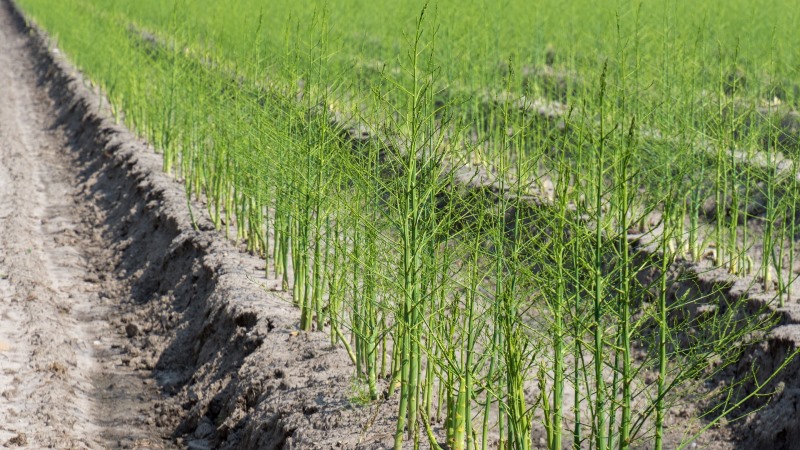
Asparagus seeds have a dense shell. This factor prevents the culture from giving quick and friendly shoots. To make the plants germinate faster, the seeds are pretreated. There are several ways to "wake up" them:
- Scarification of the seed coat. They take fine-grained sandpaper and lightly file the shell of the planting material.
- Soaking in warm water for 2-3 days. Every morning the water is replaced with fresh water. The tissue is kept warm (the optimum temperature for germination is + 22 ... + 24 ° C). After that, the seeds are placed in wet sand or sawdust for 7 days. During this period, they hatch.
Asparagus is grown in seedling and non-seedling methods. In the first version, sowing is carried out in March - February. Seedlings grow slowly, in 1.5 months they reach only 15 cm. If it is not possible to grow seedlings in apartment conditions, in late May - early June the seeds are planted in the ground.
Planting seeds in open ground
Seeds are planted on a bed with a loose, light mechanical composition and fertilized soil according to the scheme:
- embedment depth - 1-2 cm;
- the distance between plants is 5–7 cm;
- row spacing - 25-30 cm.
Attention! After sowing asparagus, be patient: the delicacy will grow within 30–45 days.
Further care
Asparagus sprouts emerge in early spring and can be white, purple, pinkish white or green. It depends not only on the characteristics of the selected variety, but also on the growing conditions and the timing of harvesting.
Young shoots are thinned out, leaving the strongest and healthiest. In the first year, asparagus is not transplanted so that it grows a good root system and gets stronger. Culture dive to a permanent place after 1-2 seasons.
Growing and caring for asparagus outdoors include standard farming practices:
- Timely watering - asparagus does not like both dry soil and stagnant water.
- Regular feeding - a month after germination, asparagus is fertilized with mullein infusion (1: 5). After harvesting, a mixture of mineral fertilizers is applied annually, consisting of superphosphate, urea and potassium salt.
- Weeding weeds - they must be removed in the first year, otherwise weak asparagus sprouts will simply die.
- Loosening topsoil after watering and weeding.
- Hilling - the color and taste of the edible part depend on it. Use green and bleached shoots. No hilling is required for green asparagus. Every spring it is poured with fertile soil (with a layer of 5-7 cm). To obtain white sprouts in early spring, bulk combs are made over the asparagus. The height of the mulching ridge is at least 25–30 cm. Dry sawdust is used as mulch.
In the fall, asparagus shoots are cut close to the ground. To protect the roots from freezing, they are covered for the winter with straw, sawdust or peat.
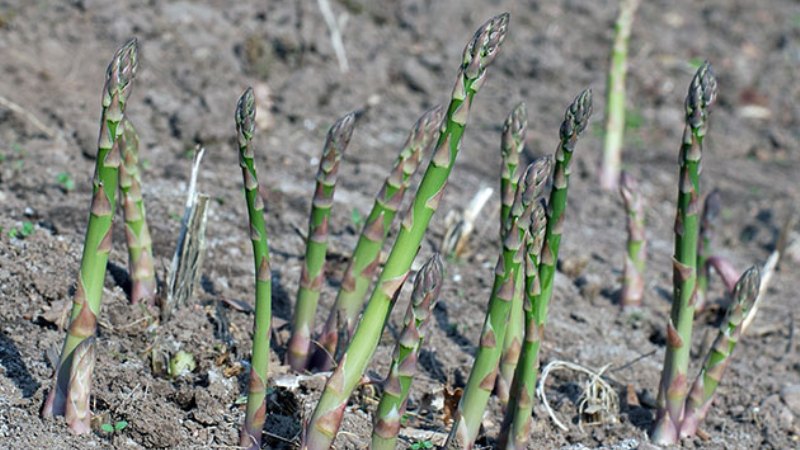
Disease and pest control
The most dangerous pests for culture are:
- Asparagus leaf beetle - a small dark blue beetle with a thin red border on the back. The beetle attacks plants in spring, eating leaves and shoots. In one season, pests give 2-3 generations. If you do not fight them, you can be left without a crop.
- Asparagus fly- small front sight of brown color, up to 7 mm long. An adult lays eggs in asparagus shoots. Larvae emerge from the eggs, which develop inside the stems, actively eating up the core part. Edible fleshy shoots lodge and turn black. In the middle lane, the fly is rare, distributed mainly in the south of Russia, in the territory of Ukraine and Georgia.
- Asparagus rattle- the beetle is black and red with white or yellowish dots on the back (from 6 to 12, depending on the variety). Distributed in the south of Russia. Hibernates on asparagus shoots.
The simplest, but ineffective way of dealing with insects is to collect them by hand. Plants are sprayed with mustard or dry ash.
As a chemical protection against pests, the following preparations have proven themselves well: "Actellik", "Tagore", "Lambda-S". The latter kills insects in a matter of minutes.
Asparagus diseases occur, as a rule, due to errors in care and worsening weather conditions (excessive watering, prolonged rains, high humidity in combination with low air temperatures):
- Fusarium. In June, the asparagus branches turn yellow, wither and dry out. At the base of the stem, purple or brown spots with a white fluffy bloom are visible on the shoots.
- Rust. Yellow-brown spots appear on the stems protruding above the surface of the leaf. Diseased bushes lag behind in development and do not give new growth. At the end of summer, they turn yellow earlier than others.
- Cercosporosis. On the leaves, gray spots appear with a dark bloom and a red-brown border.
- Red rot of roots. In infected asparagus, the root collar and roots die off. These parts of plants are covered with red spider webs - fungal hyphae.
All diseases are caused by various kinds of fungi. If the infection is not strong, a single treatment with Fundazol is sufficient. The dosage is 20 g per 10 liters of water. After treatment, the affected area is covered with plastic wrap. In case of severe infection, a new plantation will have to be laid.
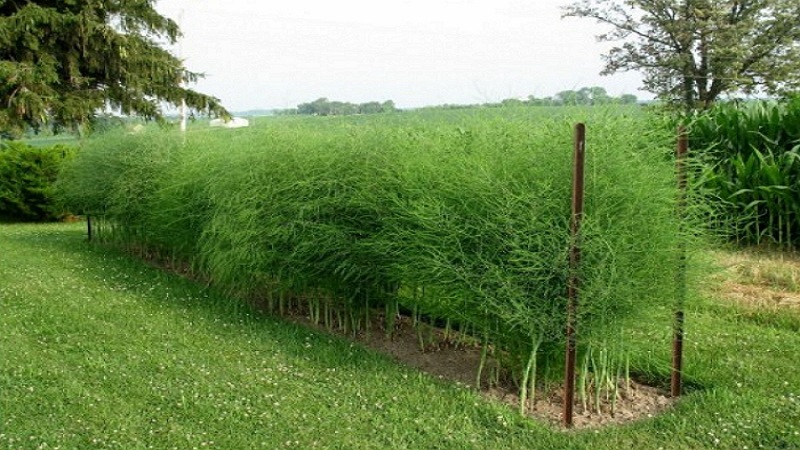
As a preventive measure against fungal diseases, it is recommended:
- annual introduction of biological products into the soil ("Fitosporin", "Trichodermina");
- processing the culture in spring and autumn with a solution of Bordeaux liquid;
- uniform watering;
- regular mineral nutrition (lack of potassium and excess nitrogen increase the susceptibility of the culture to many fungi);
- drainage of the site with a close occurrence of groundwater.
Important! Chemistry is used only after collecting edible shoots.
Harvesting
In the third year of life, the first crop is harvested. Cutting begins in early May, before the plant heads open. When growing bleached asparagus, its location in the earthen mounds is determined by the cracks in the ridge. In their place, they carefully rake the soil and cut off the white shoots. The cut is carried out in the morning or in the evening, once every 2 days.
In the first year of harvest, no more than 5 stems are removed from one bush so that the plants do not deplete. Adult bushes give up to 30 shoots for the whole season.
How to store it correctly
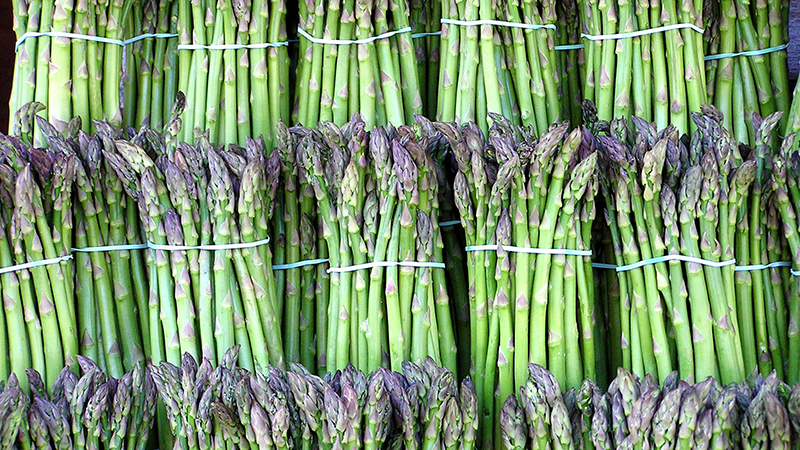
The harvested asparagus is wrapped in a clean, damp cloth and placed in the refrigerator. Asparagus is stored for up to 1-3 months. To increase the shelf life of the crop freeze or canned in brine.
Important! In the refrigerator, place the asparagus vertically so that it does not deform, away from strong-smelling foods.
Reproduction methods
Vegetative propagation of asparagus is much more efficient than sowing in the ground. In this case, more than 80% of the planted plants take root and take root.
By division
Small, but thick, well-developed horizontal rhizomes are suitable for reproduction. In early spring, they are cut into 2-3 parts so that each carries 2-3 buds. Slices are sprinkled with crushed coal. Each plot is planted in a permanent place in the soil prepared in advance.
Cuttings
With mass propagation of asparagus, cuttings from last year's shoots are cut from March to June. Each should have 3-4 buds. The cut twigs are planted for rooting in the sand, covered with foil to create a greenhouse effect.
In the morning and in the evening, the cuttings are ventilated, sprayed with warm water. They take root in 30-40 days, after which the plants are transplanted into pots or immediately to a permanent place.
Important! For quick survival of cuttings, their lower sections are powdered with "Kornevin".
Features of distillation
In order to feast on asparagus in winter, it is dug up along with a clod of earth in late autumn. They do this only when all the shoots are dry.
The root ball is planted in a voluminous box (container, pot) with fertile soil. Required container parameters: length and width - 50 cm; depth - 20-30 cm. Rhizomes are straightened and sprinkled with the same soil. The plantings are watered abundantly, covered with a film to retain moisture. The optimum room temperature is + 18… + 20 ° C. The crop will ripen in 1.5 months.
The best varieties for open ground
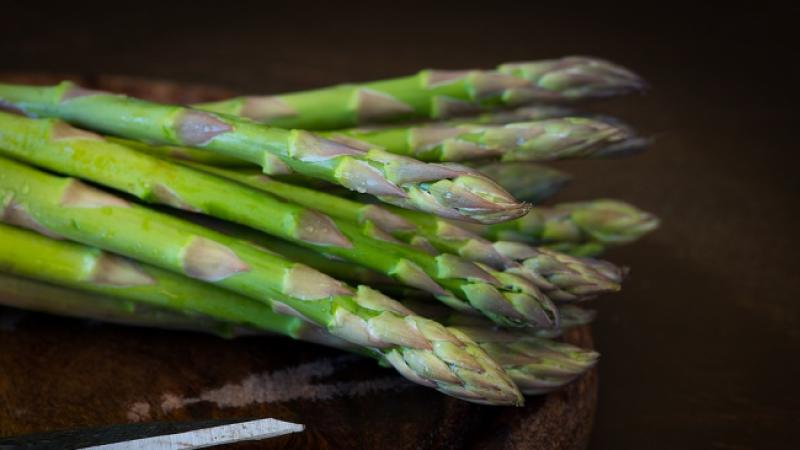
For the cultivation of asparagus in their summer cottages, breeders have bred many varieties and hybrids:
- Argenteil - early ripening and the only variety recommended for forcing at home. Differs in large, low-fiber white shoots. Ripens in early May. Asparagus is hardy and fruitful.
- Early yellow - an early-ripening variety of Russian selection with yellow shoots and milky soft pulp.
- Tsarskaya - gives white thick (up to 2 cm) and high (up to 16 cm) shoots. Features of the variety: drought resistance, frost resistance, high resistance to fungal diseases.
- Snow head - mid-season asparagus with greenish-pink shoots. The scales are pale purple. The pulp is tender, similar in taste to green peas.
- Martha Washington - an interesting mid-early variety with purple or reddish-purple color of the shoots. Resistant to rust, recommended for growing in regions with high humidity and greenhouse forcing.
- Glory of Braunschweig Is a late variety with long white shoots. Productivity is high - up to 12 shoots per season from one plant. Ideal for canning.
Conclusion
Asparagus in the country is often grown as an ornamental plant, but in vain: the agricultural technology of this vegetable crop is quite simple, it includes standard techniques (watering, fertilizing, hilling, loosening).
Asparagus is planted both in spring and before winter, monitor soil fertility, and prevent diseases and pests. The harvest of tasty and healthy seedlings is harvested only for 3 years.